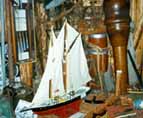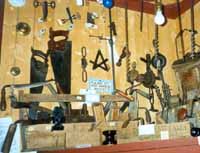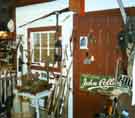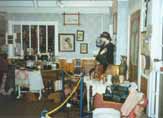The museum is divided up into four thematic areas: the
fishery, carpentry, farming, and the parlour room.
The Fishery
 Fishing
was one of the main occupations of the first settlers of Torbay. This trade
has continued on through the years until 1992, when a North Atlantic Cod
Moratorium was put in place. The Torbay Museum offers a detailed look at the
fishery in the lives of Torbay citizens. It has one entire corner dedicated to
the fishery which is filled with various artifacts.
Fishing
was one of the main occupations of the first settlers of Torbay. This trade
has continued on through the years until 1992, when a North Atlantic Cod
Moratorium was put in place. The Torbay Museum offers a detailed look at the
fishery in the lives of Torbay citizens. It has one entire corner dedicated to
the fishery which is filled with various artifacts.
The items are placed in a setting that resembles a fishing
wharf - it has a wooden cookhouse, a storage room, a splitting table and a
carrying bucket which all lie on a wooden wharf. Hauling nets hang in the
background with floaters dangling off them. On the far left, there lies a
kerosene motor engine, once used by Mr. James Eustace (Sr.) on his fishing
expeditions. Below the engine there is a killick resting against the post. The
killick is the official symbol of the Torbay Museum and was once used to
anchor boats to the seabed.
There are numerous artifacts resting on the splitting table.
There are small jiggers, which are small hooks used for catching "tom
cods" (baby cod fish). There are also hook and line reels - hand held
fishing lines that had to be spun through ones' hands quickly in order to
catch fish. On the opposite side of the table there is even a portable fog
horn that stands in excellent condition.
Carpentry
 The
carpentry section of the Torbay Museum is filled with various tools that were
used in the trade during 'the old days'. The museum is home to various types of
saws, augers - which were used for drilling holes in the ice, and a folding
measuring tape. The museum also has a mallet and some planes that were used for
coal moldings.
The
carpentry section of the Torbay Museum is filled with various tools that were
used in the trade during 'the old days'. The museum is home to various types of
saws, augers - which were used for drilling holes in the ice, and a folding
measuring tape. The museum also has a mallet and some planes that were used for
coal moldings.
Many visitors that come to the museum are simply amazed by
these artifacts. There are no electric chainsaws or drills - everything was used
by hand and without electricity. It's often said how amazing it was that people
were able to use such crude tools.
Barrels and butter churns were also popular since it was not
possible to transport items in glass. Men would go on long trips to St. John's
to deliver goods. The roads were not in great shape to travel over so carrying
tools and goods had to be carefully made to be able to endure such a task could
be completed properly.
Farming
 The
farming section of the Torbay Museum boasts many artifacts that were once used
to help Torbay with its economic growth. Although farming wasn't the primary
industry of residents - it was certainly an important one.
The
farming section of the Torbay Museum boasts many artifacts that were once used
to help Torbay with its economic growth. Although farming wasn't the primary
industry of residents - it was certainly an important one.
Potatoes, cabbage and turnip were the most popular plantation
crops grown. The growth of vegetables was a food source for the families of
Torbay and any excess vegetables would be brought to St. John's to be sold for
profit.
In the farming section the front of a barn has been created as
a backdrop with hay stacked in the side window. The entire area is fenced in -
just like the olden days. There are numerous milk jugs, a butter churn and even
an ice cream maker. A barn lantern is hung on the barn, as well as horse bells
and a horse brush. A seeder rests against the door and adjacent to that lies
different types of shovels.
Parlour Room
 In our
parlour setting, the walls are covered with old pictures - everything from
portraits to weddings. One picture is particularly striking: it's the picture of
a porcelain-faced woman names Margaret Quigley (1888-1912). Quigley resided on
Quigley's Lane, off Piper Stock Hill until the age of 24. It was at that time
she passed away from Tuberculosis - a common disease of those times.
In our
parlour setting, the walls are covered with old pictures - everything from
portraits to weddings. One picture is particularly striking: it's the picture of
a porcelain-faced woman names Margaret Quigley (1888-1912). Quigley resided on
Quigley's Lane, off Piper Stock Hill until the age of 24. It was at that time
she passed away from Tuberculosis - a common disease of those times.
Nestled among dishes arranged in a glass case lies the oldest
artifact of the museum - a two hundred year old platter that was once owned by
George White's great grandmother, a resident of Torbay.
Music lovers can check out the old wooden organ and stool, as
well as the old records and record player. For the fashion lover, there is even
a mannequin supporting the dress of the times. For the young children, there are
dolls and carriages and a Christening dress dating back more than one hundred
years.
A mixer from the 1930's is placed on a table along with an
iron toaster and various pots and pans. The table is one of the artifacts that
were collected from St. Michael's Convent before it was torn down.
In the corner, there is a dresser with a mirror. A wash jug
and basin rests up on it. There is also a shaving kit, hair accessories and an
old bottle of Colgate toothpaste.
An old parlour stove, in good condition, rests under a mantel
and is the focus point of several chairs (part of the nine-piece parlor set
received from St. Michael's Convent). There is an area that is filled with old
irons, cameras, a typewriter, sewing machine and much more. The parlour setting
is an ideal glimpse of a "Torbay living room" at the turn of the
century.
Back to the Torbay Museum
 Fishing
was one of the main occupations of the first settlers of Torbay. This trade
has continued on through the years until 1992, when a North Atlantic Cod
Moratorium was put in place. The Torbay Museum offers a detailed look at the
fishery in the lives of Torbay citizens. It has one entire corner dedicated to
the fishery which is filled with various artifacts.
Fishing
was one of the main occupations of the first settlers of Torbay. This trade
has continued on through the years until 1992, when a North Atlantic Cod
Moratorium was put in place. The Torbay Museum offers a detailed look at the
fishery in the lives of Torbay citizens. It has one entire corner dedicated to
the fishery which is filled with various artifacts.
 The
carpentry section of the Torbay Museum is filled with various tools that were
used in the trade during 'the old days'. The museum is home to various types of
saws, augers - which were used for drilling holes in the ice, and a folding
measuring tape. The museum also has a mallet and some planes that were used for
coal moldings.
The
carpentry section of the Torbay Museum is filled with various tools that were
used in the trade during 'the old days'. The museum is home to various types of
saws, augers - which were used for drilling holes in the ice, and a folding
measuring tape. The museum also has a mallet and some planes that were used for
coal moldings. The
farming section of the Torbay Museum boasts many artifacts that were once used
to help Torbay with its economic growth. Although farming wasn't the primary
industry of residents - it was certainly an important one.
The
farming section of the Torbay Museum boasts many artifacts that were once used
to help Torbay with its economic growth. Although farming wasn't the primary
industry of residents - it was certainly an important one. In our
parlour setting, the walls are covered with old pictures - everything from
portraits to weddings. One picture is particularly striking: it's the picture of
a porcelain-faced woman names Margaret Quigley (1888-1912). Quigley resided on
Quigley's Lane, off Piper Stock Hill until the age of 24. It was at that time
she passed away from Tuberculosis - a common disease of those times.
In our
parlour setting, the walls are covered with old pictures - everything from
portraits to weddings. One picture is particularly striking: it's the picture of
a porcelain-faced woman names Margaret Quigley (1888-1912). Quigley resided on
Quigley's Lane, off Piper Stock Hill until the age of 24. It was at that time
she passed away from Tuberculosis - a common disease of those times.